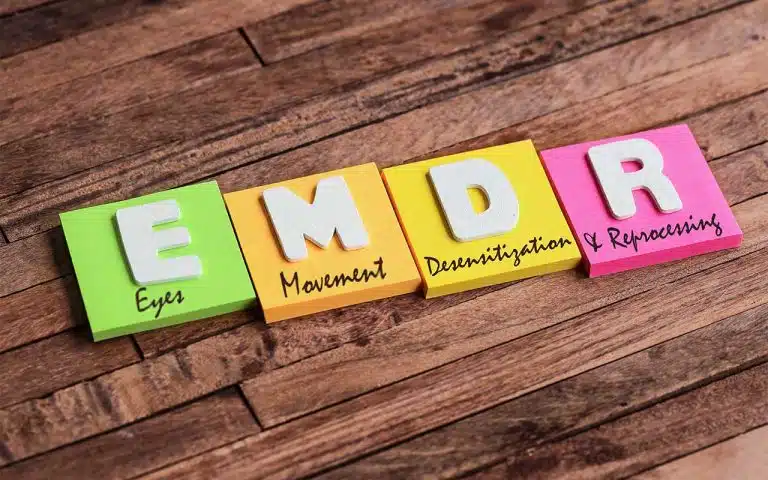Eye Movement Desensitization & Reprocessing (EMDR)

Eye movement desensitization and reprocessing (EMDR) is a type of psychotherapy designed for people with traumatic memories and post-traumatic stress disorder (PTSD).
Studies suggest it can also help people with other mental health conditions, including addiction.
How Does EMDR Work?
Psychologist Francine Shapiro developed EMDR using the adaptive information processing model. This model argues that symptoms of PTSD, such as flashbacks and nightmares, appear when the brain doesn’t properly process traumatic or disturbing events.
EMDR can help you process these events through bilateral stimulation. Bilateral stimulation (BLS) is stimulation that occurs in a rhythmic left-right pattern. Examples include:
- keeping your eyes on a light as it moves from left to right
- holding two small devices that alternate vibrations between your left hand and right hand
- putting on a headset and listening to a sound that alternates between your left ear and right ear
As the stimulation occurs, the therapist will ask you to focus on a traumatic experience. They’ll then help you identify negative thoughts or beliefs surrounding the experience, such as “I deserved it.”
Next, they’ll help you replace those cognitions with positive beliefs, such as “I didn’t deserve it, it wasn’t my fault, and I’m safe now.”
According to the American Psychological Association (APA), EMDR consists of eight phases:
History-Taking & Treatment Planning
During this phase, the EMDR therapist asks about your history and helps you identify your treatment targets, which can include past memories, current triggers, and future goals.
Preparation
The therapist explains EMDR and practices bilateral stimulation with you. They’ll also help you visualize a “safe place” you can return to if you become distressed during EMDR treatment.
Assessment
The therapist asks you to visualize the event and to identify a negative cognition and a positive cognition surrounding the event. You’ll then rate how true the positive cognition feels and how disturbing the negative cognition feels. You’ll also be asked to describe your body sensations.
Desensitization
The therapist asks you to focus on the traumatic event as you experience bilateral stimulation. You’ll then report any new thoughts or feelings, which you’ll focus on during the next round of bilateral stimulation.
Installation
The therapist asks you to focus on the positive cognition you identified in the Assessment phase. You won’t move to the next phase until the positive cognition feels completely true (a state known as “adaptive resolution”).
Body Scan
The therapist asks you to visualize the traumatic event while observing your physical sensations. If you experience any unpleasant sensations, the therapist will use bilateral stimulation to help you process them.
Closure
The therapist uses strategies to ensure you feel safe as you end the therapy session. Common strategies include visualizing your “safe place” or making a container to hold distressing feelings that may emerge between sessions.
Reevaluation
At the follow-up session, the therapist evaluates your mental state, how you’ve handled treatment effects, and any new memories or feelings you report. They also help you identify goals for the current session.
The Efficacy Of EMDR
EMDR is considered an evidence-based treatment of posttraumatic stress disorder. That means it’s been proven to reduce PTSD symptoms in numerous clinical trials, systematic reviews, and meta-analyses.
According to the United States Department of Veterans Affairs, most people who have weekly 50-to-90-minute EMDR sessions over one to three months show a noticeable improvement in PTSD symptoms.
Other organizations that recommend EMDR in the treatment of PTSD include the World Health Organization, American Psychiatric Association, United States Department of Defense, and International Society for Traumatic Stress Studies.
Some studies even suggest that EMDR is a more effective treatment than prolonged exposure therapy, which is another popular PTSD treatment.
Other Mental Health Concerns
Along with PTSD, some mental health care clinicians also use EMDR to treat other mental health concerns, such as anxiety disorders, depression, psychosis, eating disorders, low self-esteem, and addiction.
In these cases, EMDR is often used alongside other treatment services, such as cognitive-behavioral therapy (CBT) and psychiatry.
EMDR & Addiction Treatment
After a traumatic event or other adverse life experience, a person may self-medicate with alcohol or other drugs. This behavior can quickly lead to drug addiction. Indeed, according to one study, nearly 50% of people with PTSD also suffer from addiction.
EMDR can aid addiction treatment and prevent relapse in these individuals by helping them manage their traumas in a healthier way.
In addition, according to a randomized controlled trial, EMDR may be an effective psychological treatment for addiction memories (memories of past drug use). When left untreated, these memories can intensify drug cravings and lead to relapse.
If you or a loved one struggles with trauma and addiction, please contact an Ark Behavioral Health specialist to learn about our comprehensive treatment options.
Written by Ark Behavioral Health Editorial Team
©2024 Ark National Holdings, LLC. | All Rights Reserved.
This page does not provide medical advice.
American Psychological Association - Eye Movement Desensitization and Reprocessing (EMDR) Therapy
American Psychological Association - EMDR reprocessing of the addiction memory: Pretreatment, posttreatment, and 1-month follow-up
U.S. Department of Veterans Affairs - Eye Movement Desensitization and Reprocessing (EMDR) for PTSD
U.S. National Library of Medicine - Comparison of two treatments for traumatic stress: a community-based study of EMDR and prolonged exposure 01


Questions About Treatment?
Ark Behavioral Health offers 100% confidential substance abuse assessment and treatment placement tailored to your individual needs. Achieve long-term recovery.
100% confidential. We respect your privacy.
Prefer Texting?
Our friendly support team is here to chat 24/7. Opt out any time.







 Learn More
Learn More








